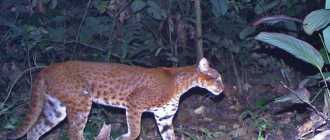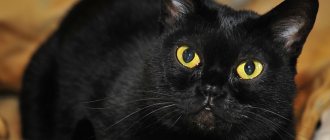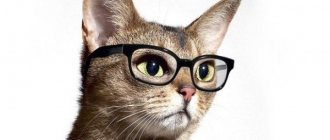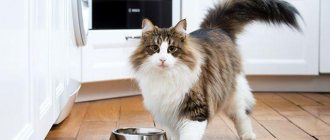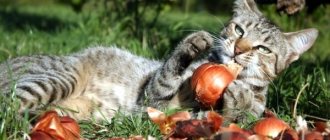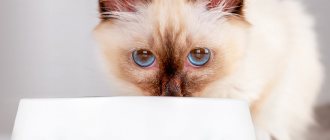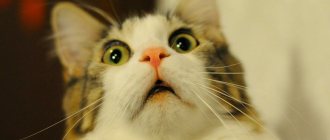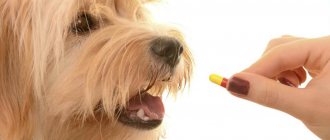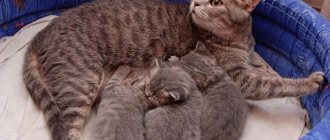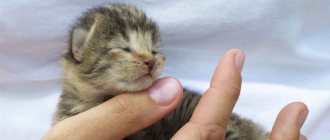Lapping mechanism
The question of exactly how cats drink has worried scientists for a long time, and in the 40s of the last century, Professor G. Edgerton from the Massachusetts Institute of Technology used stroboscopic photography to reveal the mechanism of cat lapping.
Work on studying how a cat drinks has been continued in our time with the help of high-speed photography. This slow-motion video clearly shows how a cat laps milk and exactly what movements the cat's tongue makes.
However, Edgerton's conclusions that cats use their tongues as a kind of inverted spoon when lapping turned out to be not entirely correct. A number of scientists from various scientific institutions, including the same Massachusetts Institute of Technology, have proven that it’s all about adhesion (sticking of liquid to the tongue) and high speed of movements.
And they even went further, creating a mechanical imitation of a cat's tongue. The video, slowed down 100 times, clearly shows that the liquid remains on the surface of the device for some time and rises upward.
Why do cats lap?
The drinking process in cats turned out to be much more complicated than imagined. To find out how liquid gets into cats' mouths and why amazing creatures have developed just such a mechanism, biologists and engineers conducted an experiment.
To figure out how cats lap, MIT professor Harold Edgerton used strobe photography back in 1940. Then it became known that animals bend the tip of their tongue not forward, which seems logical, but backward, so that the upper part of the tongue gets into the liquid first. At this point, it seems that the secret of lapping was revealed. It took another half a century to understand that this is not so.
Roman Stocker and his colleagues from MIT, Virginia Tech and Princeton University have shown that delicate animals do not use their tongues as a spoon. Moreover, it turns out that cats' tongues practically do not penetrate below the surface of water or milk, but only lightly touch it. This tactic is radically different from lapping in dogs, which scoop up liquid by using their tongue to form a spoon.
Stoker was prompted to undertake this interesting study by observing his own cat. Together with his colleague Pedro Reis, Roman sat for hours in front of a bowl of Katta-Katta (the cat's name), waiting for him to deign to drink. A high-speed camera was at the ready. The footage she shot served as a basis for further work. In the video presented, Katta-Katta laps at 12 times slowdown.
Thus, we managed to learn the main secret of lapping. When the tip of the tongue touches the liquid, some of it sticks to the surface of the tongue due to adhesion. And it rises very quickly - in a split second. As a result, some of the water or milk is carried upward. A column forms between the tongue and the surface of the liquid in the bowl, continuously changing its length and thickness. Two forces are fighting in this column - the inertia of the moving fluid and gravity. This delicate balance is constantly changing. But the cat instinctively knows at what moment it is most accurate: the animal quickly closes its mouth when the column of liquid is at its largest size, while biting off the upper part of the tasty column of murk. Based on the survey data, the authors of the work compiled a mathematical model of lapping. And to generalize it to all cats, scientists found recordings on YouTube that showed tigers, lions, leopards, jaguars, cheetahs and lynxes lapping.
After carefully examining the footage, biologists came to the conclusion that big cats lap in the same way as domestic cats Felis catus. The only difference is in the frequency of movements: a domestic cat laps about four times per second, while large representatives of the cat family do so somewhat less frequently. And this is consistent with the model: a larger tongue, a larger volume of water, a lower speed at which a balance between inertia and gravity is achieved in the liquid column. The amazing dexterity of cats, of course, was developed in the course of evolution. If the cat is in a hurry to close its mouth, it will get less liquid, and if it hesitates a little, the milk will completely fall back into the bowl and its jaws will close around the empty space. In order to clarify the fine details of the process, scientists even built a robotic substitute for a cat's tongue, which touches the water at high speed and rises back. In the video, the movement of this device is shown with a slowdown of 100 times.
It remains to be seen why cats came up with such an unusual method of absorbing liquid. Roman and his colleagues have an assumption: it’s all about a certain dislike of cats for water and their natural desire for cleanliness. The cat's method of lapping is much more careful than the dog's. It allows the sensitive areas around the nose and the magnificent whiskers (vibrissae), which help the predator to navigate in the dark, to be more dry. Katta-Katta also helped researchers discover that tiny hairs on the tongue, which were once thought to help cats grasp liquid, were not involved in the process.
Researchers have seen how cats lap up milk
To play, you must enable Java script support and install a new version of Flash
Run in Real Player or Windows Media Player
Cat lovers have long been interested in the question: how do their smaller brothers manage to quench their thirst so elegantly? It seems that scientists have reached the truth.
A whole team of researchers armed with high-speed cameras and, of course, the cats themselves worked on the solution.
It turned out that felines use a more sophisticated technical approach to the process of quenching thirst, compared, for example, with dogs, who drink rather sloppily, which allows cats to “save face.”
A person, like some animals - for example, sheep and horses - when consuming liquid, they literally suck it into their mouth; dogs curl their tongue into a bowl shape; cats, in turn, only touch the surface of the water without splashing it.
The results of scientific research were published in the journal Science.
Cat nature
The study was conducted by biophysicist Roman Stocker from the Massachusetts Institute of Technology. He was prompted to make these observations by his own cat named Kata-Kata.
“I realized that behind this simple action lies an interesting biological problem. After that, the project began to grow,” Stoker said.
A cat's tongue rolls inward when drinking.
Together with colleagues from Virginia Tech and Princeton University, Stocker began observing his cat and recording its actions using a high-speed camera.
“During contact with the tongue, the liquid adheres to its surface. The cat then retracts its tongue, creating a tunnel through which the water rises to the throat,” explains Stoker.
Scientists were also able to establish that a cat's tongue turns inward when drinking, and not towards the nose, and small hairs on cat tongues, contrary to existing beliefs, are not directly related to the process of lapping.
To complete the picture, using the knowledge gained, a mini-robot was created that imitates a cat's tongue
Cats vs dogs
By observing the zoo's inhabitants, as well as watching videos on the Internet portal YouTube, the researchers came to the conclusion that big cats - such as tigers, leopards and cheetahs - use the same lapping method in their natural habitat as their domestic counterparts.
Stoker and his colleagues can't say for sure why the cat family has evolved such a complex mechanism, but they suspect it may have something to do with their aversion to contact with water.
“A cat’s lapping seems much neater than a dog’s: they don’t splash water around them, but at the same time they manage to quench their thirst just as well,” explains the scientist.
“Perhaps this is explained by the special sensitivity of the cat’s face, and especially the area of the nose and whiskers, which they strive to keep dry with all their might,” Stoker believes.
“I'm sure cats are much more aware of the nature of liquids than dogs,” he added.
What kind of water should I give my cat?
Pet owners often do not think about the quality of the water they feed their pets. Meanwhile, water quality is directly related to the health of the animal. It is worth paying attention to the question of what kind of water to give to your cat. This is especially important for kittens and purebred animals. Veterinarian's advice
Cats prone to urolithiasis should be sure to drink their quota of water. This is especially true for castrated cats on dry feeding. For drinking, choose a bowl that is not very deep and wide. When drinking, the animal's whiskers should not curl. An uncomfortable bowl can discourage your cat from drinking.
Is it possible to give a cat tap water?
Almost everyone, without hesitation, gives cats water from the tap. And they themselves often amusingly lap up running water. Cats sense oxygenated liquid, which is why they prefer it. You can also observe how cats drink water from the aquarium, where it is also enriched with oxygen due to the presence of an aerator or plants.
However, tap water also poses dangers.
- Firstly, it smells like bleach and cats are reluctant to drink it.
- Secondly, due to wear and tear of the pipes, the water contains rust and other substances harmful to the animal’s body.
Therefore, veterinarians strongly do not recommend giving your cat tap water without purification.
Can I give my cat tap water?
Many people think that boiled water is healthier for animals than from the tap. But it is not so. When boiling, some of the water evaporates. And sediment appears in the liquid, the water becomes “heavy”. And this can contribute to the development of diseases of the genitourinary system of your pet.
So what kind of water is best to give to a cat?
It is completely safe to give your pet bottled water. The downside is that it is an additional cost.
Therefore, the ideal solution would be to purchase and install a drinking carbon filter. It will allow you to combine the benefits of running water and the purity of bottled water. In addition, the water from the filter can be drunk by the owners.
It is important to understand here that for humans, water from carbon filters must be boiled, because These devices do not purify water from bacteria, which are safe for animals, but can cause gastric upsets in humans.
Our store offers you to buy proven high-tech sink filters Geyser, Aquaphor or Raifil. These domestic and South Korean filters have many international quality certificates. Filters comply with Russian GOST standards.
Cats taught people how to lap properly
Having carefully studied the lapping mechanism of cats, mechanics understood the secret of feline elegance. Moreover, they were able to reproduce the process using model experiments. And now they hope to apply the knowledge gained to create biomechanical robots.
Scientists continue to study the mechanics of seemingly simple and well-known movements of domestic animals. After shaking the dog off, they tackled the cat lapping up milk. It turns out that this behavior is not as simple as it seems. It is based on the use of physical laws, or more precisely, on maintaining a precise balance of two physical forces. Roman Stocker and Pedro Reis from the Massachusetts Institute of Technology built a physical model that describes cat lapping and calculated all its parameters.
How to drink against gravity
Land vertebrates had to learn to drink water. Since jugs, cups and other convenient drinking devices were invented only by man, animals are most often forced to drink from reservoirs, that is, from a horizontal surface of water, lifting it up against the force of gravity. There are two ways to do this. Pigs, sheep, horses suck up water. Predators cannot do this; they either lick liquid (from very small puddles on the surface) or lap it up from deep containers. Probably not everyone knows that cats and dogs lap differently. Dogs lap noisily - they scoop up water with their curved tongue and carry it into their mouth. Cats act completely differently. They do this very neatly (so that neither the fur nor the sensitive whiskers get wet) and very elegantly.
The mechanics of a cat's lapping cannot be seen with the naked eye, since the domestic cat makes very frequent tongue movements - four times per second. Scientists analyzed a video recording of lapping, and for clarity, they built a physical model that imitates the movements of a cat's tongue.
A cat is not a dog at all
Scientists observed 10 domestic cats, including Stoker’s cat, eight-year-old Katta Katta. And they found out that, unlike a dog, a cat does not immerse its tongue in the liquid, but only touches its surface with the tip. In this case, the tongue bends in a hook, but does not scoop up anything. Due to adhesion to the wet tongue and the force of inertia, at the moment when the tongue comes off the surface and rises, a column of liquid follows it. Under the influence of gravity, this column breaks, but at this moment the cat manages to close its mouth to catch the drop hanging on its tongue.
In the experiment, scientists imitated the tip of the tongue with a glass disk. When the disk lifts off the surface, a column of liquid follows it. Using a model with a diameter corresponding to the size of the tip of a domestic cat's tongue, it was possible to calculate the required speed of movement and frequency of lapping. “The cat laps so quickly and with such frequency that it maintains a precise balance between the force of inertia and the force of gravity,” explains Pedro Reis. Otherwise, her tongue will work idle. Scientists joke that cats are smarter than some of us when it comes to hydrodynamics.
Large cats lap less often than small ones
Tigers, lions, panthers and jaguars lap in the same way. But their tongue works slower than that of a domestic cat. Scientists have theoretically calculated that the frequency of lapping should depend on the mass of the animal in order to maintain a balance between the two forces. They tested this in an experiment with a larger glass disk, as well as by studying videos of large feline predators lapping. The assumption was confirmed: the greater the mass, the less often the animals use their tongues.
Scientists did not study cat lapping for fun. They indicate possible prospects for applying the results obtained in an article published in Science. The tongue is adapted for such precise movements because it is “boneless,” but so is the trunk of an elephant and the tentacle of an octopus. And by studying how soft living structures move, people may well be able to create soft biomechanical robots for a wide variety of purposes.
